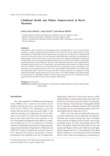Childhood Health and Mother Empowerment in Rural Myanmar
| ISSN | 00213551 |
|---|---|
| NII recode ID (NCID) | AA0068709X |

Child health is often a weak link in developing countries, and Myanmar is a case in point. Broadly speaking, a mother’s education has been shown in the literature to be an important factor in the determination of child health. But the empowerment of women over the allocation of intrahousehold resources has also been shown to be an important child health factor, and thus an accumulation of human capital. In the present study, we use survey data on an important anthropometric indicator of child health and its associated household characteristics to specify and estimate a child-health production function in rural Myanmar. We then use this production function to draw implications for the height-for-age growth curves. Importantly, our questionnaire-based indicator of empowerment shows the mother’s influence over household decisions regarding income, expenditures, and education to be an important factor in the Z-score of the height-for-age indicative of a child’s long-term nutritional status. Nearly 30% of girls and 48% of boys are found in a condition of being stunted nutritionally, and the growth curves come closer to the WHO standard as the empowerment of women improves. Although a number of women rights were achieved early in Myanmar, greater empowerment in the home remains a key to improve child welfare.
| Date of issued | |
|---|---|
| Creator | Chisa NAKAMURA Yoko SAITO Thuzar SHWE |
| Subject |
bargaining power child nutrition health production function height-for-age human capital |
| Publisher | Japan International Research Center for Agricultural Sciences |
| Received Date | 2019-03-20 |
| Accepted Date | 2019-08-08 |
| Available Online | |
| Volume | 54 |
| Issue | 3 |
| spage | 253 |
| epage | 262 |
| DOI | 10.6090/jarq.54.253 |
| Language | eng |
